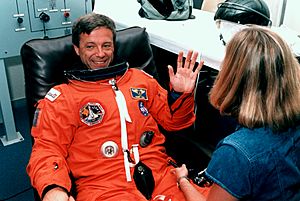Robert Thirsk facts for kids
Quick facts for kids
Bob Thirsk
|
|
|---|---|
 |
|
| Born |
Robert Brent Thirsk
August 17, 1953 New Westminster, British Columbia, Canada
|
| Space career | |
| NRC/CSA astronaut | |
|
Time in space
|
204 days, 18 hours, 29 minutes |
| Selection | 1983 NRC Group NASA Group 17 (1998) |
| Missions | STS-78 Soyuz TMA-15 (Expedition 20/21) |
|
Mission insignia
|
  |
Robert "Bob" Brent Thirsk is a Canadian engineer, doctor, and a former astronaut. He holds the Canadian record for the most time spent in space. That's over 204 days! He was born on August 17, 1953. For his amazing work, he was honored with the Order of Canada in 2013 and the Order of British Columbia in 2012.
Contents
About Bob Thirsk
Bob Thirsk grew up in New Westminster, British Columbia. He is married to Brenda Biasutti, and they have three children. When he's not busy with space missions, Bob enjoys spending time with his family. He also loves flying, playing hockey, squash, and playing the piano.
Bob has received many important awards for his work. These include the Gold Medal from the Association of Professional Engineers, Geologists and Geophysicists of Alberta in 1976. He was also the first person to receive the Distinguished Alumni Award from the University of Calgary in 1985.
Bob Thirsk's Education Journey
Bob Thirsk went to schools in British Columbia, Alberta, and Manitoba. He earned a Bachelor of Science degree in mechanical engineering from the University of Calgary in 1976. He then got a Master of Science degree from MIT in 1978.
Later, he became a medical doctor, earning his M.D. from McGill University in 1982. He also completed an MBA from MIT in 1998. In 2009, while he was actually in space, he received an honorary doctorate from the University of Calgary. This made him the first person ever to get a university degree from space! In 2019, he received another honorary doctorate from Carleton University.
Bob Thirsk's Astronaut Career
Bob Thirsk was chosen to join the Canadian astronaut program in December 1983. He started his astronaut training in February 1984. He was a backup for another Canadian astronaut, Marc Garneau, for a space shuttle mission in 1984.
Bob has worked on many projects for the Canadian Space Agency. These include studies on how space affects the human body. He also helped plan missions and worked on educational programs. He even led a team that studied how weightlessness affects the heart. They designed a special "anti-gravity suit" to help astronauts in space.
Leading Space Missions and Research
From 1993 to 1994, Bob Thirsk was the Chief Astronaut for the Canadian Space Agency. In 1994, he commanded a simulated (pretend) space mission called CAPSULS. This mission lasted seven days and involved other astronauts and scientists.
On June 20, 1996, Bob Thirsk flew into space for the first time on Space Shuttle Columbia. This mission, called STS-78, lasted 17 days. He and his six crewmates did 43 experiments. These experiments studied how space affects plants, animals, and humans. They also looked at how materials behave in microgravity (weightlessness).
During this mission, Bob wrote articles for the Calgary Sun newspaper. This was the first time an astronaut wrote and published a story while still in orbit!
Training for the International Space Station
In 1998, Bob Thirsk began training at NASA's Johnson Space Center in Houston. This training taught him about space shuttle and International Space Station systems. He also learned about spacewalks (EVA) and robotic operations. He even learned Russian!
He worked as a CapCom (capsule communicator) for the International Space Station program. CapComs are the main communication link between Mission Control on Earth and the astronauts in space. They help with planning and solving problems.
In 2004, Bob Thirsk spent eleven days living and working underwater in an underwater laboratory. This was part of the NEEMO 7 mission, which helps astronauts prepare for space.
He also trained at the Yuri Gagarin Cosmonaut Training Centre in Russia. He became certified to fly the Soyuz spacecraft.
Long-Duration Spaceflight

Bob Thirsk was part of the Expedition 21 crew on the International Space Station. He launched on the Soyuz TMA-15 mission on May 27, 2009. He was the first Canadian astronaut to fly on a Soyuz spacecraft.
About this mission, Bob said it would be "the supreme thrill of my life." He studied the long-term effects of zero gravity on the human body. His findings helped scientists understand how people can live in space for a long time. He returned to Earth in November 2009.
During his time on the space station, two other Canadians visited him. These were astronaut Julie Payette and space tourist Guy Laliberté. The meeting between Bob Thirsk and Julie Payette in July 2009 was the first time two Canadians met in space!
After His Astronaut Career
After retiring from the Canadian Space Agency, Bob Thirsk continued to contribute to science and education. From 2012 to 2014, he worked for the Canadian Institutes of Health Research. This is a government agency that invests in health research.
In September 2013, a high school in Calgary, Alberta, was named after him: Robert Thirsk High School.
On July 1, 2014, Bob Thirsk became the Chancellor of the University of Calgary. In 2021, he visited the UK and gave a speech at Loughborough Grammar School.
Awards and Honors
Bob Thirsk has received many awards for his contributions to space exploration and science.
- He was made an Officer of the Order of Canada.
- He became a Member of the Order of British Columbia.
- He received the Queen Elizabeth II Diamond Jubilee Medal.
- He was awarded the NASA Distinguished Public Service Medal.
- He also received the NASA Space Flight Medal.
- Russia awarded him the Medal "For Merit in Space Exploration" for his work in international space cooperation.


